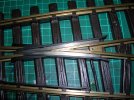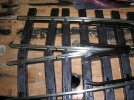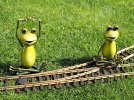You are using an out of date browser. It may not display this or other websites correctly.
You should upgrade or use an alternative browser.
You should upgrade or use an alternative browser.
Live frog vs dead frog - pros and cons
- Thread starter Ralphmp
- Start date
JimmyB
Now retired - trains and fishing
A powered live frog will almost completely eliminate point "stutter" for track power, and is very popular in the small finer scales, having no "dead rail", whereas LGB for example is not only dead frog but does not even have point switching to allow points to isolate tracks. For me, if I were using track power live frog every time, but it is what is produced by the big manufactures'.I get that one is powered and the other isn’t but why would you choose powered vs unpowered?
Live frog has advantages and disadvantages. In its favor is better power to the loco as it traverses the points as pointed out by Jimmy. This is particularly helpful to short wheelbase locos. The major disadvantage is that it will short out if traversed backwards against the setting whether deliberate or accidental. In other words it cannot be used for a sprung turnout. A second disadvantage is the additional cost and added complexity.
It would be nice if the major manufacturers gave the option though.
It would be nice if the major manufacturers gave the option though.
Last edited:
To me for reliable running of smaller locomotives live frogs are a must. I went to the trouble to convert all of my Peco Points to live frogs and elsewhere except in my low level fiddle yard have used TL45 with live frogs. There are certain requirements with wiring as it is possible on a passing loop to create a short situation. But as I made all my points in effect a separate section feeding the tracks each side of a passing loop as a separate section those problems are eliminated.
I do take the point with running over points and allowing them to trail to the route and do this with LGB R1’s on my loft line. These are of course not live frog so no shorts are encountered.
Having seen your line Martyn there may indeed be a small amount of wiring required if you converted to live frogs. But that would not necessarily be back to your panel, just some additional isolators and jumper wires.
I do take the point with running over points and allowing them to trail to the route and do this with LGB R1’s on my loft line. These are of course not live frog so no shorts are encountered.
Having seen your line Martyn there may indeed be a small amount of wiring required if you converted to live frogs. But that would not necessarily be back to your panel, just some additional isolators and jumper wires.
ntpntpntp
Registered
I absolutely advocate live frogs in the small scales, eg. my N gauge exhibition layouts. For the reasons given in the previous posts.
When my garden line was active, I ran a mixture of loco brands including short wheelbase locos without skates. The different flange depths meant that not all would reliably pick up power by the flange edges from the metal strips in the bottom of LGB R5 frogs, resulting in a significant "dead spot".
I converted my R5s to live frog by removing the plastic V and replacing with something created from brass rail. This also required cutting the wire links which usually maintain both routes as live, and fitting a feed to the metal frog with a changeover switch attached to the point motor (in other words exactly the same arrangement as my n gauge live frog points). Result = perfectly smooth slow running of any loco

I also developed a conversion for Peco G45 points, though I never actually used them myself I converted a couple for a friend.

When my garden line was active, I ran a mixture of loco brands including short wheelbase locos without skates. The different flange depths meant that not all would reliably pick up power by the flange edges from the metal strips in the bottom of LGB R5 frogs, resulting in a significant "dead spot".
I converted my R5s to live frog by removing the plastic V and replacing with something created from brass rail. This also required cutting the wire links which usually maintain both routes as live, and fitting a feed to the metal frog with a changeover switch attached to the point motor (in other words exactly the same arrangement as my n gauge live frog points). Result = perfectly smooth slow running of any loco

I also developed a conversion for Peco G45 points, though I never actually used them myself I converted a couple for a friend.

Ralphmp
Registered
Thanks guys - appreciate your clarity and patience. As i run either DCC or occasional battery power I may have to convert my “live“ frog to a dead one (!) or figure out some funky wiring. (Phil S - agreed; have been using a Massoth power buffer for some time and point stutter has been eliminated.)
Oh there is a firm in Germany that do conversions for LGB Track. Can’t remember who, perhaps someone with a better memory than me can post a link?Thanks guys - appreciate your clarity and patience. As i run either DCC or occasional battery power I may have to convert my “live“ frog to a dead one (!) or figure out some funky wiring. (Phil S - agreed; have been using a Massoth power buffer for some time and point stutter has been eliminated.)
Software Tools
Registered
Oh there is a firm in Germany that do conversions for LGB Track. Can’t remember who, perhaps someone with a better memory than me can post a link?
This is the firm that I am aware of..... Weichen 45mm ... there may be others too.

Rhinochugger
Retired Oik
This is one of the reasons why I run US outline locos - lots of wheels.
Anything less than a 6-coupled loco with tender is battery powered.
Anything less than a 6-coupled loco with tender is battery powered.
When I was into track power with all of my outside pointes live frog, I found that reliable running was only truly possible with Articulated Locomotives, Harz 2-10-2’s, Diesels and 8 wheel Railcars. Despite a clean up of the track to shiny condition on the day. Getting fed up with track cleaning prompted my conversion to all battery in the garden. But there is no doubting that live frogs made a bug difference. Some would likely say that my track laying was not adequate and to a certain extent I would agree. But billiard table track in the garden is near impossible thus live frogs do give you an edge. But Stainz will never be a reliable slow speed shunter in the garden even with live frogs. Though it may work ok at top speed.
Ralphmp
Registered
So overall, I think what folk are saying is that
live frogs aid certain locos to traverse points at slow speed, but
they require discipline in use to ensure “push throughs” don’t happen as this could/would cause a short circuit (depending on how the point blades and frog are wired).
live frogs aid certain locos to traverse points at slow speed, but
they require discipline in use to ensure “push throughs” don’t happen as this could/would cause a short circuit (depending on how the point blades and frog are wired).
Rhinochugger
Retired Oik
Your controller should be able to deal with the short i.e. shut down OK, but the train will stop.So overall, I think what folk are saying is that
live frogs aid certain locos to traverse points at slow speed, but
they require discipline in use to ensure “push throughs” don’t happen as this could/would cause a short circuit (depending on how the point blades and frog are wired).
I have a pet hate against push through for any model railway setting - the scale weight ratio doesn't really stand up to the concept IMHO
Ralphmp
Registered
Yep, I avoid if at all possible. I have a cunning plan for my live frog points that will give access to a siding off the mainline. Based on info gleaned from several posts on the forum, it goes like this:
This should help ensure trains on mainline come to a halt before threatening to push through the points with the frog set to the wrong polarity.
In addition, if I install some kind of clip on the brass strip/rodding that has to be undone before the points can be set for the siding, this will help me to ensure mainline traffic approaching the points from the “wrong“ direction is brought to a halt.
Come to think of it, I have a mini signal box somewhere so if I can figure it out, I can use that to house EPL motor and rodding lock.
- Deploy a LGB EPL motor with supplementary switch.
- House motor in a convenient building (I have a number of unmade Pola kits that will do for this).
- Connect motor to points using either brass rodding or strip - ie don’t connect directly to the points.
- Install an isolating section of track ”downwind” of the points on the mainline
- Wire supplementary switch so when points are set for siding, frog polarity is set correctly AND power is cut from isolating track on mainline.
This should help ensure trains on mainline come to a halt before threatening to push through the points with the frog set to the wrong polarity.
In addition, if I install some kind of clip on the brass strip/rodding that has to be undone before the points can be set for the siding, this will help me to ensure mainline traffic approaching the points from the “wrong“ direction is brought to a halt.
Come to think of it, I have a mini signal box somewhere so if I can figure it out, I can use that to house EPL motor and rodding lock.
JimmyB
Now retired - trains and fishing
The IOM steam at Port Erin has push throughs, or so I am lead to believe. I am sure somebody will correct me if I am wrongYour controller should be able to deal with the short i.e. shut down OK, but the train will stop.
I have a pet hate against push through for any model railway setting - the scale weight ratio doesn't really stand up to the concept IMHO

